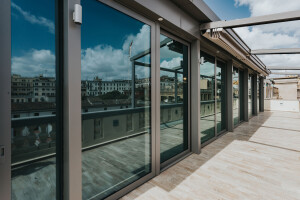Many families with children search for the edge of the city. With an open and creative mind, our client was looking for a suitable place within the city and found an empty attic on the fourth floor between two higher apartment buildings. Although the city seems to be fully built up, there are still many unused spaces.
The pitched roof makes place for a duplex roof house, accessible by the existing staircase of the building. The lines of the wooden cladding fit in the orange-yellow horizontal brick facades of the street. The roof house forms the crowning glory of the existing apartment building and completes the park wall. The design is an architectural accent for its surrounding, and is at the same time integrated into the urban context.
The roof house is the result of an intense participative collaboration, a big commitment of the client and a constructive attitude of all parties and administrative authorities involved.
Passive housing
We built passively and with a sustainable character. By filling in a residual space, we are helping to increase the density of the Brussels living fabric. Spatially qualitative spaces aim for a beloved living environment so that as few changes as possible will be required in the future. However, the light walls are making simple changes still possible. On the one hand, the main use of local wood as a post-renewable construction material was an environmentally conscious choice. On the other hand, this construction method is also limiting the weight on the existing foundations.
A passive construction between and on the surrounding existing buildings required optimal technical solutions and a precise (and challenging) execution. Energy consumption was limited by avoiding thermal bridges and choosing the right glazing and ventilation systems. In addition, energy is actively extracted with solar collectors for domestic hot water and PV panels for electricity. A condensing natural gas boiler provides the little remaining energy required.
Spatial living
The aligning and the oblique plot boundaries form the basis for the design of the facades and the dwelling. The available space was used to the maximum. The open entrance hall in the middle of the house forms the link between the sleeping area at the back, the bathroom and the cooking and dining area at the front. A light wall contains all closed functions: technical space, deep larder units as maximum utilized storage space, toilet and bathroom. Moreover, the entrance gives access to the new staircase that winds space-consciously above the existing staircase. Upstairs, there is a work or play area at the front and a sitting area with a sun terrace at the back. The step to this terrace is both sitting and storage space. The front facade has been slightly withdrawn to allow a smaller protected terrace with a view on the park on top of the existing bay window.
Large windows open the house to the urban fabric of Brussels. The terraces ensure easy maintenance. Thanks to a void at the staircase, light can enter the heart of the house. During the day the incidence and experience of light is changing according to the position of the sun. The structural wooden beams were kept visible as much as possible. Wooden slats were also used in the handrails and parapet. They adapt when more transparency is needed and serve as a guideline throughout the house.












































